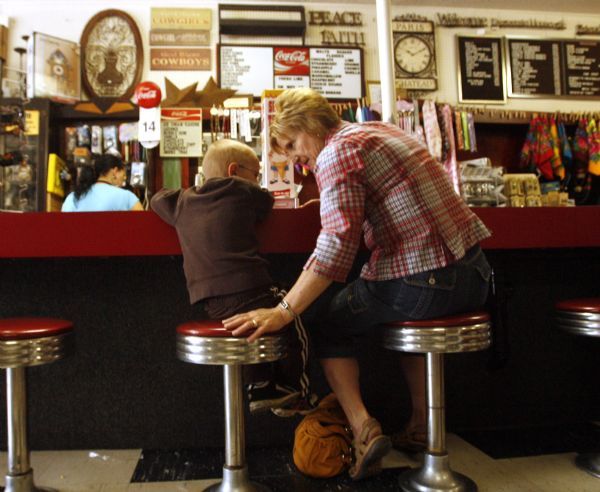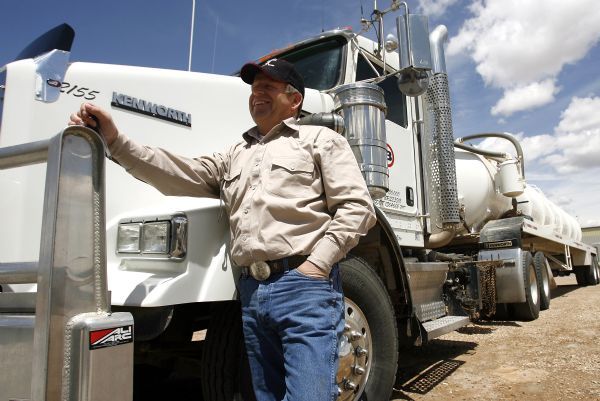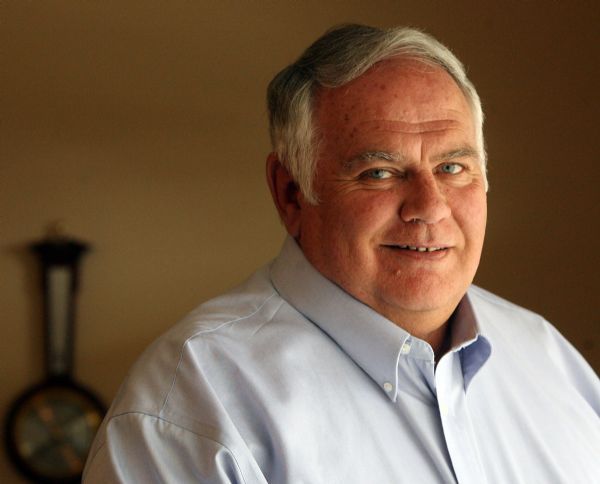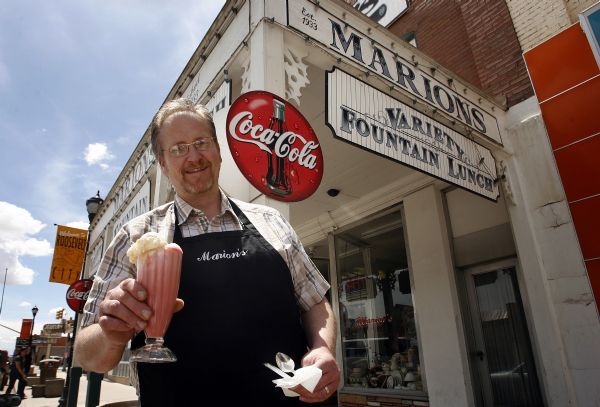This is an archived article that was published on sltrib.com in 2010, and information in the article may be outdated. It is provided only for personal research purposes and may not be reprinted.
This is part of an ongoing series looking at small towns throughout Utah and their unique ways of life. To read previous stories about Helper, Beaver and Randolph, go to www.sltrib.com.
Roosevelt » The gigantic Nabors Well Service trucks hauling erector-set-like equipment slowed traffic approaching Duchesne County's largest town.
To someone not from the Uintah Basin, the long traffic jam seemed irritating. But since the steel structure being slowly pulled by a large truck helps bring oil out of the ground, workers and equipment on the road near this town of 5,000 residents means something else.
Jobs.
"If you come here between 5:30 and 7:30 a.m., you will see an exodus of people," said Johny Thayne, the safety coordinator for the Bill Barrett Company. "They are going out to do their job so you can heat your house, run your car or turn on your lights."
Roosevelt is a working person's town, inhabited by laborers who toil at nearby energy and farm fields. Visitors find few tourist facilities but do see a town with schools, colleges, government and infrastructure catering to oil and gas production and agriculture.
Drive into Roosevelt from the west on U.S. 40. Hit the city limits and you will be greeted by farm-equipment stores, the big Moon Lake Electric headquarters and all sorts of large industrial buildings and yards associated with producing oil and gas from public and Ute Indian lands surrounding the town.
Conversation about the energy industry is common in a town where the Uintah Basin Applied Technology College has a decorated oil derrick in front of its campus and where classes in energy services, safety, heavy-equipment operation, petroleum technology and truck driving are taught.
For example, at the end of a busy lunch rush at the venerable Marion's gift shop, soda fountain and lunch counter -- a third-generation Roosevelt institution established in 1933 -- worker Kevin Mortensen talked about energy politics. This is a common theme in a town whose existence relies on decisions made about how the public lands that surround it should be managed.
The Obama administration, which canceled oil leases in the area, is a common target.
"Things have slowed down a bunch with this government," Mortensen said. "People started getting scared when Obama was elected."
The town's reliance on the energy industry often results in boom-and-bust cycles that can see its population rise and fall by 1,000 in short periods of time. It once boasted a refinery, but that closed and was dismantled.
"We had a boom until 1 1/2 years ago when the current administration cut back on the oil leases in the area," said Mayor Vaun Ryan, a soft-spoken man who lives in a well-kept home just off U.S. 40. "The Bush administration leased out a lot of federal ground for oil and gas, and the government cut back on a bunch of those. That put a chink in the exploration, which is a big part of our economy. We've seen dramatic changes. A lot of people left the area. But it's stabilized a bit and come back a little in the past six months."
Ray Morlan, a Basin native whose father worked in the oil industry, works at Nabors Well Service. His company is busy these days. As someone involved in the industry most of his life, he knows its value to Roosevelt.
"It would turn into a ghost town without the industry," he said. "Either you work in the oil industry, know somebody who works in the industry or you are a farmer. There are not a lot of other things going on out here."
Morlan doesn't think many urban dwellers know the value of oil and gas or realize that the paraffin-heavy oil that comes from the ground here is used in makeup and even ChapStick.
"Those nasty old pumping units and black oil are all they understand," he said.
Workers such as Bill Barrett's Thayne bristle when outsiders tell them they are not protecting the place where they live and make a living. Thayne echoes a theme often heard from rural Utahns.
"We have been raised here on this land," he said, "and are the best environmentalists."
On summer weekends, many Roosevelt residents head to the Echo Drive-In.
"It's a great family thing," said Wilma Snow, who owns the theater on the west end of town with her husband, Richard.
The drive-in movie theater, with its worn playground in the front of the screen, is 52 years old this year. But that has nothing on the other Roosevelt theater the Snows own. That would be the Uinta in the middle of town. It's over 100 years old, almost as old as the town.
Marion's
Chad Mortensen may not know the name of every customer who comes into Marion's in Roosevelt, but he usually knows what they are going to order. Marion's is named after Mortensen's late aunt, who founded it originally as a gift and notions store in 1933. It moved to its current location in 1944 and was also owned and operated by Chad's father, Eldon.
In the early 1950s, Marion Mortensen brought in a soda fountain and small grill. These days, it features one of Utah's few working soda fountains. This is a place where you can still order a cherry ice cream soda in an old-fashioned glass, share a malt mixed in a metal container served in a stainless-steel holder with a paper cup or enjoy an Ironport phosphate.
The grill specialty is a double cheeseburger coated with Marion's secret barbecue sauce. Then again, the Spam and cheese sandwich has an old-fashioned appeal.
Union High School
Roosevelt is home to "half a high school."
Union High, named because it unified parts of Uintah and Duchesne counties, sits right on the border of the two counties and on the line that separates Roosevelt and Ballard. In fact, the county and city lines go right through the building.
While most of its students hail from Roosevelt, some come from Uintah County and the nearby Ute Indian Reservation.
That could change, though. According to Roosevelt Mayor Vaun Ryan, Duchesne County School District is contemplating building a new high school entirely in Roosevelt.
Golf Course
The back nine of Roosevelt's 18-hole golf course has an interesting history.
In 1990, Gordie Harmston, who is a descendant of town founder Ed Harmston and then owned a motel and restaurant, and about a dozen volunteers decided to design and build the course's back nine themselves because the town didn't have enough money to hire an architect or do the construction. The volunteers researched other courses. The scenic back nine includes a hole with an island green, a par 5 with a split rocky fairway and a brutal par-3 hole with an elevated tee and a tiny green. Contractors donated equipment, an oil company contributed fuel and a paving contractor put in 7,000 feet of cart paths at 50 percent of the normal cost.
Currently, the course is open but struggling. Much of the course has been reseeded, and golfers are looking forward to later in the summer when the course is expected to be in better shape.
Tom Wharton
The history of Roosevelt began in 1905 when, according to John D. Barton of the Utah History Encyclopedia, Congress opened up unallotted land of the Ute Indian Reservation to homesteading. The town itself was founded in 1906 when Ed Harmston turned his homestead claim into a townsite and laid out plots. The Harmston family remains a strong interest in town to this day.
The original town was named Dry Gulch, but Harmston's wife, Mary, objected to being called a "Dry Gulcher." So Ed Harmston told her to name the new city. Mary was a friend and great admirer of President Theodore Roosevelt and, after some correspondence from the president, decided the town should be named after him.
Roosevelt is on U.S. 40 south of the Uinta Mountains in northeastern Utah at an elevation of 5,250 feet and, according to Barton, was incorporated by 44 residents on Feb. 21, 1913. It is home to about 5,000 residents as well as Duchesne County's only hospital.











